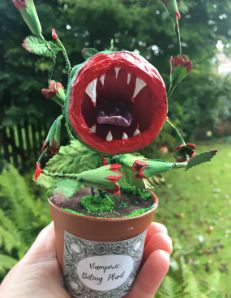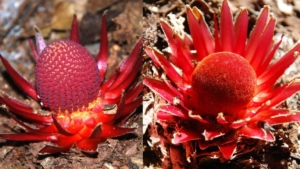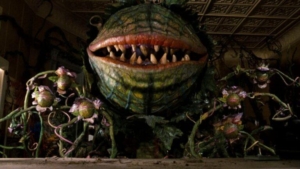DCPA NEWS CENTER
Enjoy the best stories and perspectives from the theatre world today.
Enjoy the best stories and perspectives from the theatre world today.
From the moment we are born until the instant that we die, we hunger. This is our healthy natural instinct as living creatures. We hunger for what will sustain us — physically, emotionally, and in our souls.

Horticultural humor…
If our needs are even modestly met, our hungers will retain their modest proportions. But if our needs are not met, at least at some minimal level, our hungers are apt to swell beyond their natural forms. They will become distorted and inflated. One common distortion of an unmet hunger is when we try to compensate for an absence of love with overeating. That is, we “feed our hungry heart” with literal food, as the author Geneen Roth has taught us.
But overeating is a pretty benign compensation for unmet hunger, when compared to what can happen when a deprivation of love deepens toward life-threatening starvation. The Jungian analyst Jean Shinoda Bolen concludes in her book The Ring of Power, “I am convinced that we come into the world seeking Love, and when we don’t find love, we settle for Power.”
We encounter several ominous problems when we substitute Power for Love in the diet of our human souls.
First of all, Power is not a nourishing basis for human life, as Love is when it is embraced in its healthy forms. Power only gives us a temporary rush, the “fix” that we get from the substances that we call “addictive” — cocaine, heroin, meth, and fentanyl, of course, but also sugar and adrenaline. The initial sensation we get from our first encounters with these substances is surprising and exhilarating. But it takes more and more of the substance to achieve that “high” with every subsequent “hit.” And the “high” wears off faster and faster. We can say that when compared to Love, Power delivers “empty calories,” much as sugar delivers “empty calories” when compared to protein and complex carbs. Love supports a healthy autonomous human; Power creates something very different, something very unhealthy for the soul that feeds on it.

…and an actual vampire lily
This brings us to the second serious problem with Power. It creates addicts who are profoundly dependent on ever-increasing doses of Power. And in order to obtain the swelling hits they crave, Power addicts must find living victims on whom they can exercise their Power to achieve their high. Or, after years of Power addiction, they need more victims just to feel alive.
And here comes the third danger in an addiction to Power. Most Power addicts learn that few victims are lured if their only bait is aggressive command. They come to understand that a much more effective bait is seduction. The forms of seduction that Power addicts employ are almost as numerous as the addicts themselves. Disguise and deceit are advisable because few victims want to be fed upon. But the best bait is bribery with promises of things that the victim wants. Money, sex, and status are usually tempting. But most often and most successfully, the Power addict promises their prospective victims some form of Love.
This is infernally ironic, of course, because the Power addict doesn’t know the first thing about authentic Love. Fortunately for the Power addict, this doesn’t matter because many prospective victims don’t know much about real Love, either. They certainly yearn for it, but their actual experiences of Love have probably been fleeting or traumatic. We know this because if they had ever had a fulfilling relationship with Love, even briefly, they wouldn’t fall for the counterfeit promises that the Power addict dangles as bait.
So what does all of this have to do with Little Shop of Horrors? Or to step more closely to the story of the play and the title of this essay, what does any of this have to do with blood?
To answer that question, let’s step even farther… Let’s step back 5,000 years, to the time when humanity first started telling stories about a mythic figure that has haunted our lore ever since, and all around the world. I’m talking about the deadly and seductive monster that the Babylonians called ekimmu, and that we now call Vampire.

Male and female forms of the Vampire plant, Langsdorffia hypogea
It’s important to know that all myths describe the human experiences that we have had trouble putting into abstract concepts. One mesmerizing story can help us understand someone who has deeply befuddled or disturbed us. In the case of the vampire, the myth describes a terrifying humanoid entity — that is, someone who has a human appearance but who does not display any related humanity, and especially not at key moments. This humanoid imposter is basically a parasite, a creature that sustains itself by drinking the blood — that is, the lifeforce — of living humans. And the vampire also craves power over its victims, frequently turning them into grotesque duplicates of itself.
You probably know that vampires are said to be active only at night, and that’s been the case in most of the world’s vampire myths throughout history. Vampires find us more vulnerable when we’re less alert, closer to our emotions than our intellects, and easier to mislead.
Vampires also have acute instincts for the yearnings of their intended victims. Does a victim hunger for money? Meaning? Passion? Protection? Vengeance for the hardships they have suffered? Local success? Global conquest? Immortality? The vampire will promise it all. They are masters of seduction; it’s just a seduction without consummation.
But vampires do not only use seduction. Sometimes, because it will be more effective, they revert to dominant commands and even threats of aggression, especially if they sense that the targeted victim will respond to those tactics.
And of course, it would be a fatal mistake to think that Power addicts only take a male shape. Just as in the plant kingdom (where the vampire plant has both male and female forms), so do vampires, and also the Power addicts that I am describing with the vampire metaphor. The male form of the vampire usually presents as a traditionally masculine humanoid, caped in power, while the female vampire is more inclined to be disguised by a veil of traditional feminine vulnerability

Little Shop of Horrors
Now that I’ve taken you on this tour of the relationship between Love deprivation, Power addiction, and vampires, I don’t think I need to write a string of paragraphs about how these topics relate to the story and characters in Little Shop of Horrors. We arrive in a universal Downtown where everyone is in a state of extreme deprivation from everything that they yearn to Love. This is when we should recognize that Little Shop is not as much of a dark fantasy as we would like to believe. People like these are easily recognizable in our own world.
Many people today, just like Audrey, have sought tragically harmful substitutes for Love. Many people today, just like Mushnik, once knew what they wanted to Love, but they have almost given up on ever getting it. Many people today, just like Seymour, have had so little opportunity to consider their possibilities for Love that they have no idea of what they might Love…until they stumble over it by accident. And many people today, much like Chiffon, Crystal, and Ronnette, reach for whatever forms of Love appear to be nearest at hand in the moment.
All of these characters, and all of the people who resemble them (including the people whom the playwrights have invoked with their miscellaneous fans of Audrey II) are easy prey for the voracious plant and the Power addicts that it clearly resembles. Audrey II is a Power plunderer who rolls through the disguises of vulnerability, gratitude, friendship, patronage, partnership, and finally, protector…until it becomes evident that its true purpose is none of these human motives. Audrey II is an inhuman predator — exploitive and devouring, infinitely ambitious and devoid of remorse…or empathy…or anything remotely resembling Love.
But by the time that becomes clear, it’s too late to stop the plant. Its predation and contamination have broken free of all humane constraint. Power is now the dominating paradigm…a paradigm of domination.
BARBARA HORT, PhD serves as the Psychodramaturg on the Denver Center Theatre Company’s Little Shop of Horrors. She has maintained a private practice in Portland, Oregon for over three decades, based on the work of the psychoanalyst Carl Jung. Dr. Hort has served as psychodramaturg on numerous productions at the DCPA and Portland Center Stage, providing material on the play’s psychological dynamics that is used by the artists creating the production. She is the author of Hollow Crown of Fire: A Discovery of Meaning in the Coronavirus Pandemic and Its Predecessors (2023) and Unholy Hunger: Encountering the Psychic Vampire in Ourselves and Others (1996).
